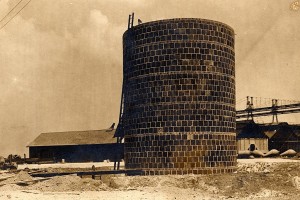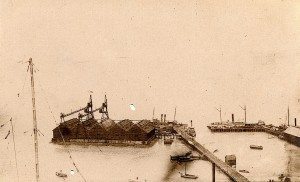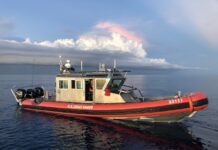The growth of Key West and its eventual naval and transportation influence on the world can be attributed in large part to an ideal maritime location, fresh water, coal, and fire.
With the advent of the Industrial Revolution came an engine that would accelerate the rate of expansion and wealth in Key West. The steam engine was the catalyst for change in many industries.

Steam powered ships traveled significantly faster than sailing ships. Steam powered electric plants brought power to whole cities. Steam powered trains revolutionized land travel.
Coal powered steam was the fuel of choice in the 19th and early 20th centuries. Coal was imported and stored in dockside warehouses called coal depots. Water tanks scatter the docksides of Key West’s port with supplies of fresh water for steam engine boilers. Coal-fed fires under boilers filled with water produced steam that powered pistons and turned wheels to provide power for a wide range of uses.
The use of steam power dates back some 2,000 years but wasn’t perfected for widespread use until the middle of the Industrial Age. From its beginning days, Key West relied on coal. In 1820 Commodore Porter commanded the Sea Gull, the first steam powered ship in the U.S. Navy, as part of his fleet. Thanks to its cutting edge technology, the steam-powered ship helped to end piracy throughout the Caribbean.
There is also evidence that Key West was using steam power during the Civil War. Wide scale electrical distribution began when Thomas Edison switched on his steam powered electric system in New York City in 1880. By 1887, electricity was being generated for general consumption by the Key West Electric and Gas Company in one of the island’s first private steam plants.

The importance of a large supply of coal is apparent when you consider our strategic location. A common stop-over for most of the steam powered ships traveling the East Coast of the United States headed for Caribbean, South American or Gulf of Mexico destinations was Key West. It was one of few deep-water ports available to provision ships and stock up on coal and water for the rest of the journey.
A good example of this took place with the flight of thousands of prospectors to the California Gold Rush in the 1850s. The fastest way from the East Coast of the United States to California was to book passage on a steam ship and travel to Nicaragua. From there you had to cross the continent at its narrowest point on foot. Having successfully completed your trek, you would catch an awaiting steam ship on the Pacific Ocean side to continue your trip to San Francisco.


























